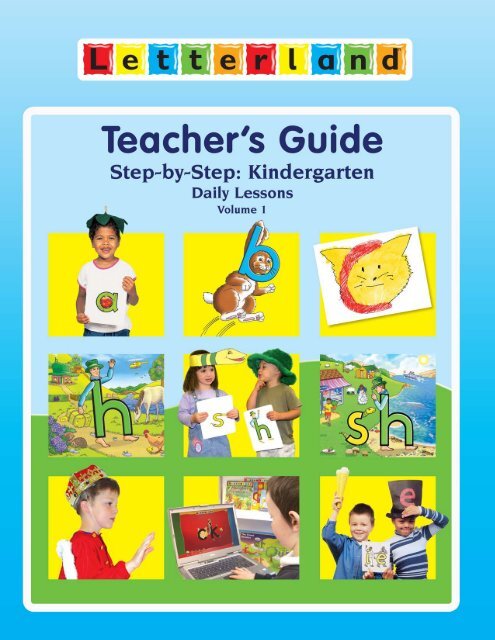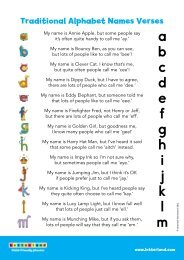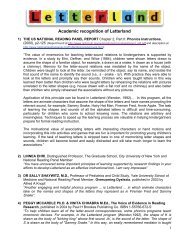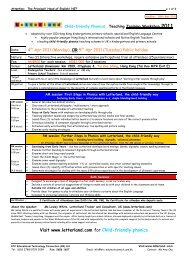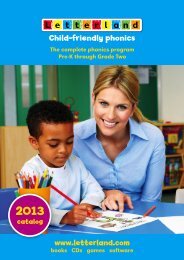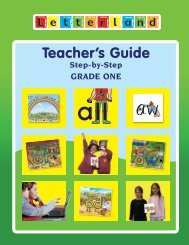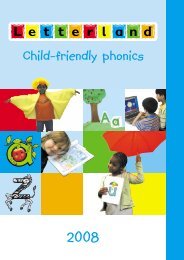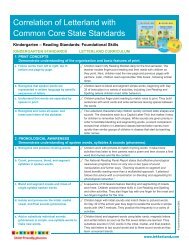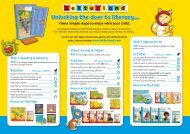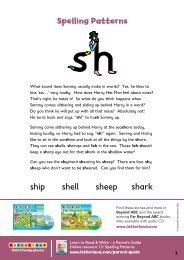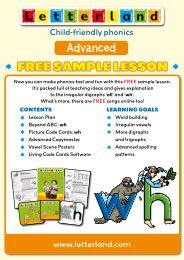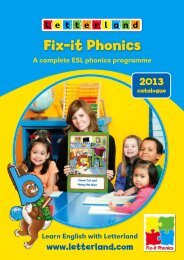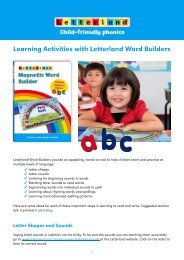Sample Pages - Letterland
Sample Pages - Letterland
Sample Pages - Letterland
You also want an ePaper? Increase the reach of your titles
YUMPU automatically turns print PDFs into web optimized ePapers that Google loves.
<strong>Sample</strong> <strong>Pages</strong>Volume 1 of the full printed guide covers:Section 1. Phonemic Awareness Fast Track (Lessons 1-18)Section 2. a-z Word Building (Lessons 19-87)Small Group InterventionThe balance of Section 2 (Lessons 88-107) and Sections 3-7 (Lessons 108-180) arecovered in Volume 2.The full printed guide is 284 pages in total. This e-book preview contains the followingsample pages:What is <strong>Letterland</strong>?Volume 1 Contents SpreadScope and Sequence (Volumes 1 and 2)Section 1:Section 2:Why a Fast Track for Phonemic Awareness in Kindergarten?Fast Track <strong>Sample</strong> Lessons: e, f, g, ha-z Word Building <strong>Sample</strong> LessonsAnnie Apple’s SoundAnnie Apple’s Letter ShapesFirst Blending: mat, cat, mad, had, ham, dad, hatSegmenting: it, is, his, him, hit, hat, hats, had, hid, did, dig, digsAssessment Record for Lessons 43-60Letter Sound Fluency / Letter Name Check – Student PageWord Reading Fluency Lessons 19-60 – Student PageBlending and Segmenting with chIntervention Objectives and AssessmentsThe Five Steps to Intervention<strong>Sample</strong> of Step 1: Letter SoundsIndex to Teacher’s Guide CD1 ContentsPlease note:This e-book contains sample pages only - the full printed guide is 284 pages in total.
© <strong>Letterland</strong> International Limited. All rights reserved.RWhat is <strong>Letterland</strong>?Explain <strong>Letterland</strong> to your children along the following lines…When most people look inside a book, all they see are plain, black letters. That’s because they haven’tbeen to <strong>Letterland</strong> and they don’t know that every letter is really one of our <strong>Letterland</strong> friends.<strong>Letterland</strong> is the secret place where all the letters live together. The friendly letter people and animalswho live there are called the "<strong>Letterland</strong>ers."Every <strong>Letterland</strong>er has a special sound, and they love it when we make their sound. Did you knowthat they have made up a special trick just to help you learn all their letter sounds? They also haveall sorts of other tricks to help everyone learn to read and write.Would you like to go to <strong>Letterland</strong> and meet some of the <strong>Letterland</strong>ers?To make the imaginative journey to <strong>Letterland</strong>, you could sing the <strong>Letterland</strong> Song together,jump into a giant book, pretend to fly, or simply close your eyes and open them again in<strong>Letterland</strong>, ready to meet a new <strong>Letterland</strong>er.Introductioniii
© <strong>Letterland</strong> International Limited. All rights reserved.ContentsA Message from Lyn Wendon ..............................................viForeword by Dr Rebecca Felton ..........................................viiIntroductionviiiLesson Plan Structure .............................................................xiUsing these Lesson Plans ....................................................xiiTeaching Support .................................................................xivWhy <strong>Letterland</strong>? .....................................................................xv<strong>Letterland</strong> Materials ............................................................ xviiSECTION 1:Phonemic Awareness Fast Track 1Why a Fast Track for Phonemic Awarenessin Kindergarten? ............................................................... 2What Teachers need to know about the Fast Track ........... 4Fast Track Procedures ............................................................ 6Fast Track Contents ................................................................ 9Lessons 1-18 ...........................................................................10Phonemic Awareness Fast Track Assessments ................31Vocabulary Cards Word List .................................................38SECTION 2:a-z Word Building 39Lessons 19–20 Cc Clever Cat .......................................43Lessons 21–22 Aa Annie Apple ....................................51Lesson 23 Review Cc and Aa ........................55Lessons 24–25 Aa Mr A, the Apron Man ....................56Lessons 26–27 Dd Dippy Duck .....................................60Lessons 28–29 Hh Harry Hat Man ...............................64Lesson 30 Review Dd and Hh .......................67Lessons 31–32 Mm Munching Mike ..............................69Lessons 33–34 Tt Talking Tess ....................................73Lesson 35 Review Mm and Tt .......................76Lesson 36 First Blending .................................78Lessons 37–41 Ss Sammy Snake ................................80Lesson 42 First Segmenting Words ...............89Assessment for Lessons 19-42 ............................................91Assessment Record for Lessons 19-42 ..............................95Lessons 43–44 Ii Impy Ink ..........................................98Lessons 45–46 Ii Mr I, the Ice Cream Man ............ 102Lessons 47–48 Nn Noisy Nick ..................................... 105Lesson 49 Review Nn and Ii .......................... 110Lessons 50–51 Gg Golden Girl .................................... 112Lesson 52 Segmenting .................................. 116Lessons 53–54 Oo Oscar Orange ............................... 117Oscar’s Bothersome Little Brother ................................... 120Lessons 55–56 Oo Mr O, the Old Man ....................... 122Lessons 57–58 Pp Peter Puppy .................................. 125Lesson 59 Segmenting .................................. 129Lesson 60 Review Gg, Pp and Oo ................ 131Assessment for Lessons 43-60 ........................................ 133Instructions for New Assessments ................................... 135Assessment Record for Lessons 43-60 ........................... 136Lessons 61–62 Ee Eddy Elephant .............................. 140Lessons 63–64 Ee Mr E, the Easy Magic Man ......... 144Lesson 65 Blending and Segmenting ..........147Lessons 66–67 Uu Uppy Umbrella ............................ 148Lessons 68–69 Uu Mr U, the Uniform Man .............. 153Lessons 70–71 Kk Kicking King ................................. 156Lesson 72 Review Ee, Kk and Uu ................ 160Lesson 73 ck Blending and Segmentingwith -ck ........................................ 162Lesson 74 Blending and Segmentingwith –ng ....................................... 164Lesson 75 Sound and Spelling for sh .......... 166Lesson 76 Blending and Segmentingwith ch .......................................... 168Lesson 77Blending and Segmentingwith th ...........................................170Lesson 78 Review ch, ck, ng, sh, and th .....173Lessons 79–80 Ll Lucy Lamp Light ............................176Lessons 81–82 Ff Firefighter Fred ..............................179Lesson 83 Blending with -ff .......................... 182Lesson 84 Blending and Segmentingwith -ff, -ll .................................... 184Lessons 85–86 Bb Bouncy Ben .................................. 186ivContents
© <strong>Letterland</strong> International Limited. All rights reserved.Lesson 87 Review Bb, Ff, and Ll .................. 189Lessons 88–180 See TEACHER'S GUIDE: VOLUME 2Small Group Intervention 192The Five Step Daily Intervention Lesson ........................... 192Intervention Objectives and Assessments ...................... 196Step 1: Letter Sounds .................................................. 198Step 2: Beginning Sounds in Words ......................... 201Step 3: Blending and Word Recognition ..................204Step 4: Phoneme Segmentation and Spelling ......... 210Step 5: Sentences and Stories ................................... 213Word Bank for Step 2: Listening forBeginning Sounds ........................................................ 215Letter Sound, Word, and Sentence Lists forIntervention .................................................................... 216Lesson Log for Kindergarten Intervention ....................... 218Appendices 219<strong>Letterland</strong> Strategies ........................................................220Child Strategies ................................................................. 221Sounds Trick .................................................................. 221Letter Sounds and Letter Names ................................222Capital Letter Trick .........................................................223Character Names Trick .................................................225Action Trick .....................................................................226Alliteration Trick and Game .........................................228Rollercoaster Trick .........................................................228Slow Speak Trick ...........................................................230Costumes and Props ................................................... 231Teacher Strategies ............................................................232Letter Sounds Pronunciation Guide ............................232Quick Dash ....................................................................233Guess Who? ..................................................................234Picture Coding ...............................................................234Reading Direction .........................................................235My <strong>Letterland</strong> Reading Booklet ...................................236Word Wall ......................................................................236The Look-say-cover-write-check Strategy ..................237Live Reading ..................................................................237Live Spelling ...................................................................238Dealing with Exceptions ...............................................238Pocket Chart Reading and Spelling .............................239Chalkboard Reading and Spelling ..............................240Reading with <strong>Letterland</strong> Word Builders ...................... 241Spelling with <strong>Letterland</strong> Word Builders .......................242Getting "bdpq" right from the start ..............................242Spelling Boxes ...............................................................243Handwriting Activities ...................................................243Air-writing ......................................................................243Rainbow Writing / <strong>Letterland</strong> Snapshots ...................244Cross-curricular Opportunities ....................................245Letter Names: Timing and Teaching ...........................246Promoting Attention and Active Listening ..................249Eyes Shut Riddle Game .................................................250Community Involvement ............................................... 251Activity Bank 252Letter Sound Activities .......................................................252Actions Game ...............................................................252Sounds Box ...................................................................252Sound Pops ...................................................................253Who’s Missing? .............................................................253Letter Sounds Train Game ...........................................253Beginning Sounds in Words ...........................................254Listen and Jump Game ...............................................254Sort it Out! ......................................................................254Alliterative Story Sentences ..........................................255Human Sounds Machine ............................................255Knock, Knock ................................................................255<strong>Letterland</strong> Jingles ..........................................................256Tray/Hoop Game ..........................................................256Who Likes? ....................................................................257Memory Game ..............................................................257Letter Shapes .....................................................................257Letter Hunt .....................................................................257Blending and Segmenting ..............................................258Blending Clues ..............................................................258Vowels Go-Round .........................................................258Short Vowels Bingo .......................................................259Full Circle Game ............................................................259Silly Questions ............................................................... 261Glossary ...............................................................................262Index.....................................................................................263List of TG CD 1 Contents ....................................................264Contents v
<strong>Sample</strong> <strong>Pages</strong>Page xiScope and Sequence (Volumes 1 and 2)• An overview of the Kindergarten Lesson Plans and Assessment OutcomesPlease note:This e-book contains sample pages only - the full printed guide is 284 pages in total.
Sections 1 - 71 Phonemic Awareness Fast Track (1–18) Vol. 1● An effective way to meet or review the a–z<strong>Letterland</strong> characters and learn their lettersounds● Develop awareness of initial sounds in words● Lessons 1-18 to cover in 18 to 25 days© <strong>Letterland</strong> International Limited. All rights reserved.Scope and Sequence (Volumes 1 & 2)Assessment Outcomes● Say the 26 a–z <strong>Letterland</strong> characternames● Say the letter sounds a–z in response tothe plain letter● Sort words according to initial sounds● Sequence three spoken letter sounds2 a–z Word Building (19–107) Vol. 1 & Vol. 2● Focus on each a–z letter in more detailincluding handwriting, capital and lower case● Build words beginning with the first six letters● Introduce long vowels while keeping the focusof word building on short vowels● Introduce common consonant digraphs:ch ck sh th th ng● Introduce basic irregular words along withdecodable words in reproducible storybooklets3 Onsets and Rimes (108–137) Vol. 2● Activities for using analogy to readand spell words● 15 short vowel word families to developautomatic word recognition with word cards● Word building and sentence building activities● More decodable booklets4 Consonant Blends (138–148) Vol. 2● 11 lessons for teaching consonant blendsbl cl fl gl pl slbr cr dr fr gr pr trsc sk sp st sm sn sw5 Long Vowels and Magic e (149–162) Vol. 2● 11 lessons for teaching little words ending inlong vowels and words with Magic e:he me she, no go so, my fly try, etc.a-e e-e i-e o-e u-e6 Vowel Men Out Walking (163–172) Vol. 2● 12 lessons for teaching vowel pairs with longvowel sounds:ai ay ee ea ie oa ue7 The Vowel Stealers: r-controlled vowels(173–180) Vol. 2● 12 lessons for teaching r-controlled vowels:ar er ir or urLetter Sounds (a–z, ch, ck, sh, th, ng)● Say the letter sound in response to theplain letter with accuracy and fluency● Write letter(s) in response to sound● Match upper and lowercase letters(Aa–Zz)Words● Blend CVC words accurately and fluently● Segment and spell CVC words● Read a selection of high frequency words● Decode words on the basis of analogywith rhyming words● Decode words more efficiently by‘chunking’ simple rimes (e.g. c-at, h-at)● Read decodable words and a selection ofhigh-frequency words in sentences andstories● Spell CVC words● Segment CCVC/CVCC words● Read additional high-frequency words● Blend and segment words with Magic epattern● Read and spell little words with longvowels at the end● Read additional high-frequency words● Blend and segment CVVC words● Read additional high-frequency words● Blend and segment words withr-controlled pattern● Read additional high-frequency wordsIntroductionxi
<strong>Sample</strong> <strong>Pages</strong><strong>Pages</strong> 2-3Fast Track Introduction: Why a Fast Track for Phonemic Awareness in Kindergarten?• FAQ on the effectiveness of giving children early access to the alphabetical code by learningthe letter sounds.<strong>Pages</strong> 14-15<strong>Sample</strong> Lesson 3: Eddy Elephant and Firefighter Fred<strong>Sample</strong> Lesson 4: Golden Girl and Harry Hat Man• Emphasizes listening and speaking skills• Multisensory skills of stretching words to identify the individual letter sounds.Please note:This e-book contains sample pages only - the full printed guide is 284 pages in total.
© <strong>Letterland</strong> International Limited. All rights reserved.Why a Fast Track forPhonemic Awarenessin Kindergarten?Experienced kindergarten teachers and early literacy researchers know thata beginning class of five year olds includes an exceptionally wide range ofpre-literacy knowledge and skills. One child knows the names of all the 52 capital and lowercase letter shapes and can match these with initial sounds in words, while another child onlyknows the first letter in his or her name.Teachers and researchers also know that one of the main reasons for these huge differences isthe experience the child has with literacy prior to coming to school. One child has been readto at every turn and taught letters and sounds under the consistent attention of a parent orpreschool teacher. The other child has seldom even seen anyone reading at home and has notbeen encouraged to learn about those strange tiny marks called letters.How does the <strong>Letterland</strong> Fast Trackhelp close the gap?With the <strong>Letterland</strong> Phonemic Awareness Fast Track teachers can begin to close this gap withan early, rapid, multisensory involvement in the world of the twenty six a-z <strong>Letterland</strong>ers alongwith their sounds, and with 3 key words linked orally and meaningfully to each letter character.All this is designed to take place in the first 18-25 days of school. This innovative lift-offstrategy for early access to the alphabetic code has these purposes:● to provide a quick ‘alphabet immersion’ experience, so every childhas at least an early, nodding acquaintance with all 26 lowercaseletter shapes and their sounds.● to teach three alliterative words for each letter, visually, verballyand conceptually (using 78 pictures on the Vocabulary Cards) sochildren can connect the initial sound of each of those words to itsown <strong>Letterland</strong> character. (The word sides of these cards are taughtlater, using the 31 decodable words first.)● to familiarize children with the a-z alphabet sequence.● to build an awareness of the phonemes, the building blocks of words,through the simple strategy of just starting to say the <strong>Letterland</strong> charactername in order to speak and hear the phoneme, e.g. “Annie Apple, /ă/.”(As one amazed teacher reported, “Once they know what to listen for,they begin to hear sounds in all kinds of words!”)● to replace the confusion of letter names (l ell, r are, w double-u,etc.) with pure phonemic sounds learned by cues at the start ofevery easy-to-remember character name.Each character is associated visually with the letter shapes and alliterativelywith the phoneme (e.g. Lucy Lamp Light, Red Robot, Walter Walrus).(Teachers report that this approach helps not only their struggling learnersbut also many otherwise well-prepared children, who are neverthelessconfused about the relationship of alphabet names to sounds.)2Phonemic Awareness Fast Track
© <strong>Letterland</strong> International Limited. All rights reserved.Isn’t this pushing children with too much, too soon?Children absorb this highly useful knowledge through a series of activities (AlphabetLine, Live Word Sorting, Order Please!). They give the Fast Track activities their fullattention because it’s like playing a game.The idea of quickly bombarding children with so many letter shapes, sounds andwords would not make sense using only plain letter shapes. What makes this startingstrategy viable and exciting is the impact of the humanized characters bonded intothe plain letter shapes and given conceptual links to their Vocabulary Cards. Eachcard becomes a prop in a mini role-play exercise. As each child impersonates a<strong>Letterland</strong>er, declaring its sound and the three key words within this playful routine,their own imaginative involvement in the special world of <strong>Letterland</strong> causes both boysand girls alike to take early possession of all 26 basic a-z shapes and sounds.How does this affect oral language and socialdevelopment?The Fast Track routine opens up welcome opportunities for personal and socialdevelopment. Through the simple act of impersonating one letter, each child presentshimself or herself to the others in an easy but satisfying form of role play.Learning to speak up and present themselves with confidence before their classmatesand later to wider audiences, are skills children often learn best at an early age. Theycan present the routine before visitors to the classroom, for example, and this can bean important experience. Or they can share it in an assembly, with the added value ofenlisting older children’s participation and encouragement across the school.Will this work with learners new to English?Children with little or no English can easily take part. They benefit from the repetitionbuilt into the routine and its core vocabulary, presented as large pictures and largewords. They will also be more ready and able to participate when the programpresents a-z again, this time in depth by working through the system.What does this edition offer over and above the2003 edition?This edition greatly expands the support for the teacher who is guiding the Fast Track.Complete day-by-day lesson plans take you through the introduction of two new<strong>Letterland</strong>ers per day, plus cumulative learning activities.Built into the 18 days of Fast Track instruction are four ‘Assessmentand Review’ days with activities to consolidate and to track individualchildren’s learning. Also, new to this edition is an ‘InterventionSection’ that let’s you use information gathered from assessmentsand observation to provide the additional small group instructionwhere needed.This Fast Track has been in use for several years now. Teachers reporttheir children love it, and that as a result, they are gaining fasteraccess to exploring their world through reading and writing.Phonemic Awareness Fast Track 3
© <strong>Letterland</strong> International Limited. All rights reserved.pictures. Let the child go through the cards again and have the children whoare sitting down say the chant with them. Work toward them being able to say itmostly from memory and with a rhythm like a rap song. To facilitate this rhythm,go down the a b c d line saying each chant and then have the class repeat eachchant in sequence again.● Explain that this is a memory game. First they will be using the pictures, butlater they will want to remember the words without the pictures.Lesson 3Eddy Elephant andFirefighter FredQuick Dash: a–d✔ Preparation and materials• Big Picture Code Cards (BPCCs):e, f• Picture Code Cards (PCCs): a-f(Use only short vowels)• 18 Vocabulary Cards, 3 for eachletter: a, b, c, d, e, f• 6 headbands● Let’s see if we remember some of the friends we have met in <strong>Letterland</strong>. Allowthree seconds after showing the card, then ask, Who is this? (Turn the card,)What’s her/his sound? (If you forget the gender, check for it in the sentence onthe plain side of the BPCC.)Introducing Eddy Elephant● Big Picture Code Card (BPCC) Hold up the EddyElephant BPCC and say, This is Eddy Elephant. This is howhe looks in <strong>Letterland</strong>. Luckily we get to see him, but mostpeople only see his plain letter in words. (Turn card.) That’sbecause <strong>Letterland</strong> is a secret place! But we are going toopen up the secret and find out all about it, because this is asecret for sharing!● Sound Help the children to discover how the SoundsTrick works with rubber-band stretching for this <strong>Letterland</strong>er, Eddy Elephant /ĕ /.● Vocabulary Cards Display the three cards and point to them while you sayEddy likes to say /e/ in words like elephant… and...? (Children add egg, elbow.)Praise with the short e word: Excellent!!Introducing Firefighter FredBig Picture Code Cards © Lyn We● Use the same routines for introducing Firefighter Fred with his BPCC. Display hisVocabulary Cards. Point to the pictures and say, Firefighter Fred likes to say /fff/ at thestart of words like fish…, and fire... and …? (Children add flowers) All repeat. Doyou know what Firefighter Fred would say if he was here? I think he’d say, “Fantastic!”Do you think ‘fantastic’ might be one of Firefighter Fred’s favorite words? "Yes" Why?"Because fantastic begins with his sound!" Stretch out the word fantastic tofind the first sound and stretch Firefighter Fred again, to make the point.Alphabet Line: a–fFirefighter Frank joins Fi● Repeat this game activity. Help the children to line up in a-f order so they cantake turns saying, “I’m Annie Apple. I say / ˘ / in a …,” etc., but this time addingthe other words:14Phonemic Awareness Fast Track
© <strong>Letterland</strong> International Limited. All rights reserved.“I’m Eddy Elephant. I say /ĕ / in words like egg and elbow and elephant.”“I’m Firefighter Fred. I say /fff/ in words like fish and fire and flowers.”● They rotate their three Vocabulary Card pictures to show everybody and toremind themselves of their words.● <strong>Letterland</strong> Detectives Each day remind the children to look at school andat home for the new <strong>Letterland</strong>ers hiding secretly behind their plain letters,as well as those they have already met. But don’t call their names out too loud.Remember they like to keep their names a secret.● Fun Idea If possible, take some photographs of the children in the AlphabetLine, showing different Vocabulary Cards in front for different shots. Use thephotos to talk about the words later. Can everyone remember the cards behindthe one each child is holding? Promise to play the game again so everyonewill have a chance to be a <strong>Letterland</strong>er, and to be in a photograph. You canbuild an Alphabet Line of photos gradually showing a–z on the wall or bulletinboard or project them on a screen to provide variety when reviewing thesounds. If practical, give children copies of the photos.Lesson 4Golden Girl andHarry Hat Man✔ Preparation and materials• Big Picture Code Cards (BPCCs)g, h• Picture Code Cards (PCCs): a-h• 12 Vocabulary Cards, 3 for eachletter: e, f, g, h• 4 headbandsQuick Dash: a–f● Let’s see some of the friends we have already met in <strong>Letterland</strong>. Remember toallow three seconds after showing the card before asking, Who is this? Turn thecard. What’s his/her sound? The pause gives all the children a chance to thinkand recall. Use a random order.Introducing Golden Girl● Big Picture Code Cards (BPCC) Show the card forGolden Girl and introduce her in the same way as forthe previous characters. Have children repeat her name.Show the plain side which is all that most people see,because they don’t know the secret of <strong>Letterland</strong>.● Sound Help the children to discover how the SoundsTrick works for Golden Girl, /g/.● Vocabulary Cards Display in a row, point to the relevantVocabulary Cards and say, Golden Girl likes to say /g/ at thestart of words like goat and …? (Children say green and grapes.)Introducing Harry Hat Man● Use the same routines for introducing Harry Hat Man with his BPCC. Displayhis Vocabulary Cards. Point to the h pictures and say, Harry Hat Man likes towhisper /h/ at the start of words like … (Children say hat and horse and house.)Phonemic Awareness Fast Track 15
<strong>Sample</strong> <strong>Pages</strong><strong>Pages</strong> 51-53<strong>Sample</strong> Lesson 21: Annie Apple’s Sound• Review of letter sounds• Introducing the reading direction• Sound, action and song• Phonemic awareness and language development• Small group/independent activities.<strong>Pages</strong> 53-54<strong>Sample</strong> Lesson 22: Annie Apple’s Letter Shapes• Review of letter sounds• Letter shapes, lowercase and capital• Sentence copymaster• Small group/independent activities.Please note:This e-book contains sample pages only - the full printed guide is 284 pages in total.
© <strong>Letterland</strong> International Limited. All rights reserved.Lesson 21: Day 1Annie Apple’s Sound✔ Preparation and materials• BPCC: a plus Review PCCs• Alphabet Songs CD, #2 Option:write on chart or project lyrics,TG CD 1• ABC book, p 2-3or Living ABC Software(includes song above)• Vocabulary Cards for a• Classroom labels; Word Wallwords• A-Z Copymasters, ˘ (Annie aApple)• Optional: an atlas to showAfrica and Antarctica• A Reading Direction sign✔ Small group/independent• Beginning Sound Picturesfor a, the a letter card, and5-7 pictures for other initialsounds, TG CD• Workbook 1, pp 4-5• a to picture-code, CDAction (page 148)Annie Apple's Alphabet SongReview● PCCs c, p, q, r, s, t, u, v, w, x, y, z. Use the 'Quick Dash' (page 233).Annie Apple, her sound, action and song● Annie Apple So who will we be learning about next? It's timeto listen and think! Listen for the clues but don’t say the answeruntil I ask, ‘Who is it?’ Speak slowly. She can hang from abranch like an acrobat. She has animal friends including anant-eater and two antelopes. She is sort of round and redand lives in a tree. Who is she? “Annie Apple.” Absolutelyright! Show Annie Apple using your Big Picture Code Card(BPCC) to remind the children how this talking apple lookswhen she is in <strong>Letterland</strong>. Annie Apple is one of five specialvowel letters that we will be learning more about in <strong>Letterland</strong>.You will find at least one of these special vowel letters in almost every word! Havechildren repeat her name twice while you show the picture side. Can you pointin the direction that Annie Apple is looking? What direction is that? “The ReadingDirection.”● Show her plain letter side of the BPCC to remind everyone what Annie lookslike in words. Ask children to point to the plain letter to show where her leafgoes and her eyes and her smile.● Sound Use the Sounds Trick (page 221) to remind them of the sound shemakes in words: Annie Apple, / a/. ˘ Ask for the letter sound / a/ ˘ in response tothe plain letter. Teach children to make Annie Apple’s Action when they makeher sound (as pictured here, and described on page 226).● Song and Action Sing Annie’s song on the Alphabet Song CD . Show the pictureside of her BPCC when you sing her name. Turn to the plain letter every timeyou sing her sound. The children make her action as they sing the sound. Or,make use of the same song on the Living ABC Software. (You may like to printthe lyrics for this song on a chart, or make a transparency or directly projectthe lyrics page from the Teacher’s Guide Copymaster CD, and do the same later forthe other Alphabet songs. After this lesson, this option will only be mentionedfor you in the ‘Preparation and Materials’ section of each lesson.)● Letter Name Tell students: People who don’t know the secret of <strong>Letterland</strong> callthis letter an “a.” (ay) We’re going to learn about that letter name later, but the mostimportant thing for us to remember right now is Annie Apple’s sound. It is a vowelsound, and vowel sounds are those that we can say with our mouths nice and wideopen without using our tongue or teeth. In just a moment we are going to say / a/ ˘three times as you look around at your friends and see how their mouths are openpretty wide, just like they are going to bite an apple. Say it with me three times andlook around. / a/, ˘ / a/, ˘ / a/. ˘ Did you see those open mouths? Now another thing thatwe can do with vowel sounds (and some other sounds too) is say them and keep onsaying them as long as we have breath like this / a……/. ˘ Do that with me and holdit out a long, long time, / a……/. ˘ So, now let’s listen for this important vowel soundas we learn more about Annie Apple.Section 2: a–z Word Building 51
© <strong>Letterland</strong> International Limited. All rights reserved.Phonemic awareness and language developmentaarrowWord WallatamIalphabetListen● ABC book Read about Annie Apple in the book or use the Living ABC Softwaresection with Annie Apple introducing herself. Emphasize her sound andexplore the picture together, looking for things that begin with Annie’s sound.● Annie’s Words Use the Vocabulary Cards ant, apple and acrobat (pictures andlargest words) and your classroom labels (e.g. arrow, alphabet) and children’snames if they begin with a short a, as in Anna) to draw attention to AnnieApple’s sound. If using names point out that these begin with Annie Apple'sCapital letter. Tell them they will soon learn about Annie Apple's Captital lettertrick. Add to your Word Wall for this lesson: at.● Questions and discussion Praise answers to these questions with ‘Absolutely!’or ‘Admirable answer!’ Be sure to listen for Annie Apple’s / a/ ˘ sound to help youanswer these questions. Is Annie Apple the first letter in the alphabet? Do you thinkshe is an adventurous apple? Which of these might she like to become, an actor?(let children answer with yes or no and then have them repeat any words thatstart with Annie’s sound), a teacher? an acrobat? a bus driver or an ambulancedriver? an astronaut? So, do you think Annie Apple is an ambitious apple? Ambitiousmeans she wants to really work hard and learn how to do lots of interesting thingswhen she grows up. Annie Apple also likes to travel. Annie has visited Africa. Let’slook for Africa in the atlas. And let’s look for Antarctica, too, while we’re at it.● A-Z Copymasters (SG) Discuss the pictures and then model finger tracing asyou say Annie’s Handwriting Verse:At the leaf begin. Go round the apple this way.Then add a line down, So Annie won’t roll away.Observe and help as needed with tracing and rainbow writing while all repeather sound, “/ ă/ / ă/ / ă/.”Games● Annie Apple’s Ask and Answer Activity Explain: I will ask you questions. All theanswers start with Annie Apple’s / a/ ˘ sound, so open your mouth and get ready tosay / a/. ˘ Call on children, or have everyone whisper the answer to a neighbor.• I am a red fruit and I grow on trees. I am an / a/? ˘ (apple)• I am a long scaly animal with sharp teeth. I live in water. I am an / a/? ˘ (alligator)• I wear a space suit. I travel in a spaceship. I am an / a/? ˘ (astronaut)• I am a small insect with six legs. I like to eat your picnic food. I am an / a/? ˘ (ant)• I have four wheels and a siren. I take sick people to the hospital. I am an / a/? ˘(ambulance)• I am a tool. I have a sharp blade and I chop wood. I am an / a/? ˘ (ax).Can anyone think of some more words that begin with Annie Apple’s / a/ ˘ sound?(Accept words you already talked about as well as any others. For a word that beginswith a different a-sound , such as Amy, Arjuno, or Audrey, explain that Annie’s letterhas more than one sound. They will learn more about those other sounds later.)Small group/independent activitiesChoose activities based on the needs of your small groups and individuals:● Beginning Sounds (SG) Annie Apple Game: Lay out the five Beginning SoundsPictures starting with / ˘ / and a the plain letter a card, mixed among 5-7 picturesthat begin with other sounds. Tell the children, Annie has dropped some of her52Section 2: a–z Word Building
© <strong>Letterland</strong> International Limited. All rights reserved.favorite pictures out of her apple tree, and they are all mixed up with other picturesthat don’t start with her sound. We are going to pick up Annie’s pictures and put themin a neat row. First, point to all the pictures and name them with the children.Have each child select a picture that begins with Annie Apple’s sound. The childpicking up the plain a card just says the sound / ˘ /. aLay each Annie Apple wordin a row and have children name all previous pictures each time a new AnnieApple word is added to the row. After all Annie Apple's pictures have been chosen,children may select others and tell which <strong>Letterland</strong>er's sound they start with.● Workbook 1 (SG) Guide the children in following the instructions on both pages.● Picture-coding (Ind) Model picture-coding Annie Apple and have each childpicture-code a large a (TG CD 1). You can model this earlier in the day andhave children do their own as an independent activity.● Handwriting Continue practice of the previous letter c, choosing frommaterials listed in the menu on page 48 or choose other activities on page 243(Handwriting instruction could take place at a different time from the rest of<strong>Letterland</strong> whole group and small group instruction).● Intervention (SG) Continue intervention activities including newly introducedactivities, such as the Annie Apple Game above, as you find them helpful.● Living ABC Software (Ind) Once children become familiar with the softwareafter two or three letters, they will be able to work fairly independentlybecause each letter is presented in the same style. In addition to the‘Activities,’ many children will want to review the characters’ interactiveintroductions of themselves. You can just add one letter at a time to thechoices with your teacher tools in this software or let more curious and moreadvanced children explore ahead on their own.Lesson 22: Day 2Annie Apple’s Letter Shapes✔ Preparation and materials• BPCCs: Annie Apple (A, a) plusReview PCCs• Annie Apple Red Vowel Reader• Handwriting Song CD, #2or Living ABC Software• Annie Apple’s name card, TGCD 1 (plus name cards forClever Cat and Annie Apple)• Sentence Copymasters, p 2✔ Small group/independent• A-Z Copymasters, A a• My LL Reading Booklet, p 2• A a to picture-code, TG CD 1• Handwriting: select fromEYH Copymasters, pp 1 and 27ELT Handwriting Book, pp 4-5Review● PCCs ă, c, p, q, r, s, t, u, w, x, y, z. Use the 'Guess Who?' activity (page 234).● Annie Apple Vowel Reader Refresh the children’s idea of this talking apple byreading to them the Annie Apple book from the Vowel Readers, Red Series. Showthe pictures and discuss the illustrations. Point out that many of these wordshave Annie Apple’s sound in the middle. In later lessons after some practice inblending sounds, you will want to let the children read this book with support.For now make it available for those who wish to explore it. You may have someself-starters reading it to you in no time!Letter shapes: a and ALowercase a● BPCC Finger-trace the a on the picture side first, and then the plain letterside, saying her Handwriting Verse each time:At the leaf begin. Go round the apple this way.Then add a line down, so Annie won’t roll away.Section 2: a–z Word Building 53
© <strong>Letterland</strong> International Limited. All rights reserved.0000AaPicture-coding● Handwriting Song Make a huge a on the board. Sing or chant the AnnieApple Handwriting Song while children slowly air trace the letter. Or, use theLiving ABC Software handwriting section for a.Capital AFirst show the a BPCC picture side. As you explain Annie’s Capital Letter Trickreveal the A PCC, explaining, Annie Apple always hops upon a nice big apple standto start important words like someone’s name, or the first word in a sentence. Ask thechildren to tell each other what you have just said. (First say it again, and makesure everyone understands what ‘a sentence’ means.)● Annie Apple Name card Show your prepared picture-coded Annie Applename flashcard, or write her name large on the board and picture-code the twoA’s. Remind children of the Capital Letter Trick: Whenever you see two wordstogether, both starting with those apple stands, it will most likely be her name. Pointto each word and have the children read her name with you, "Annie Apple."Review the Clever Cat name card.Sentence CopymasterProject the sentence or write it on the board, and give out copies of page 2. Talkabout the picture together. Now everybody listen for Annie Apple’s sound while Iread the words under the picture. Point as you read. What words did you hear thatstart with an / a/ ˘ sound? I’ll read it again, and let’s count them together. Then havechildren point to the words as you all read together. Talk about the alliterativeimages. Have children find and circle both of Annie Apple’s letter shapes, A anda, and then color the picture. Circulate and observe individuals retracing thelarge a, or writing more a’s in empty spaces on the page, to check for correctletter formation. (No child is expected to decode any of the words at this point.)Small group/independent activitiesChoose activities based on the needs of your small groups and individuals:● A-Z Copymasters (SG/Ind) Show children how to trace the capital A, firstfrom the top slanting left, then from the top slanting right, then add the appleshelf. Remind them how to trace the lowercase a and have them rainbow writein both A and a. Encourage them to write more of Annie’s letters and drawpictures that begin with her sound in the space around the large letters.● My <strong>Letterland</strong> Reading Booklet (SG/Ind) page 2. This is Annie Apple. Use fingerpointing to reread the first Clever Cat page to the children, and several timeswith them, then do this with the Annie Apple page. Have children say both pagesto a partner from memory, using finger pointing to help them to understandthe concept of word (see note, page 55). Circulate as they draw Annie Apple,asking individuals to finger point and say the words to you from memory.● Picture-coding (SG/Ind) Model picture-coding Annie Apple in her A and ashapes and have children picture-code them on their own large copies.● Handwriting (SG) Select handwriting activities from the materials box above.● Living ABC Software (SG) Once you have shown a few children how to usethe software, let that child ‘tutor’ the next child on how to use it. To keeppeace, establish that the child that is new to the software will do all thepointing and clicking. The tutor can help by answering any questions.54Section 2: a–z Word Building
<strong>Sample</strong> <strong>Pages</strong><strong>Pages</strong> 78-79<strong>Sample</strong> Lesson 36: First Blending• Review of letter sounds• Live Reading: building words by blending soundsPlease note:This e-book contains sample pages only - the full printed guide is 284 pages in total.
Lesson 36First Blending© <strong>Letterland</strong> International Limited. All rights reserved.✔ Preparation and materialsPlace a ‘Reading Direction’ sign inyour Live Reading area (p 235).• PCCs: See Review list• Optional: Props or costumesfor children doing Live Reading(p 237, p 246)✔ Small group/independent• My LL Reading Booklet, p 8• PCCs from Review list• Optional additional PCCs: ĭ, l,n, p• White boards and markersReading DirectionReview● PCCs a, ˘ c, d, d, (Dippy Duck and Diana Duck) h, m, t Use the 'Guess Who?'activity (page 234).Live ReadingBuilding the word● Pass out the Picture Code Cards for a, ˘ c, d, m, and t to five children. If usingprops or costumes, give these to the five children, also.● The children hold the cards with the pictogram side facing out. Explain thatthey are about to do what every <strong>Letterland</strong>er loves doing: making words! Theycould act as if they have just come from <strong>Letterland</strong> to show us how they do it.● Let the <strong>Letterland</strong>ers introduce themselves, “I am Annie Apple and I say a ˘ inwords, "I'm Clever Cat...” etc.● Move the ˘ , at and c children under the Reading Direction sign, line them upin this order c a ˘ t, but don’t say the word yet. The children should hold theirPCCs facing the class.● Invite the class to imagine that behind these three <strong>Letterland</strong>ers is a big pagein a book, and that the <strong>Letterland</strong>ers are building a word especially for themto read. That means they need to build the word in the Reading Direction.The ‘store and release’ technique● Have the children turn the cards around to reveal the plain letters. Ask forcomplete silence because both Clever Cat and Talking Tess only whisper theirsounds in words, and we all need to hear them.● Stand behind the three children. As you lightly touch each child they pushforward their card and whisper or say their sound, one after the other,/c/ / ˘ / a/t/. Repeat /c/ /˘ / a/t/, this time with the whole class joining in.● Next, share ‘Clever Cat’s secret:’I always sound better beside another letter,So don’t make my sound all alone.Put a nice round apple beside me,So I don’t have to be on my own.Blend ‘ca…’ then add ‘t…’● Now we are going to try using Clever Cat’s secret of making her sound togetherwith Annie Apple’s sound. Point to c, then ˘ as you say, First, just get ready to sayClever Cat’s sound, but don’t say it. Then get ready to say Annie Apple’s sound, butdon’t say it. Now, we are going to let both sounds burst out together. Are you ready?Point to or tap both children. They both push forward their cards and say,“ca…!”.● Now blend all three sounds together: “ca…t,” (the t-child pushes the t cardforward, too), “cat!” What’s our word? “Cat.” That’s right, just like Clever Cat!● Now let’s see what happens if we ask Munching Mike to take Clever Cat’s place,because this is one of the fun ways <strong>Letterland</strong>ers have of making new words.(Clever Cat sits down) Arrange the children with PCCs for m-a-t. Sound the78Section 2: a–z Word Building
1. 2. 3./hhh/4.h/˘ a ˘ a ˘a/a/t/t© <strong>Letterland</strong> International Limited. All rights reserved.word out, /mmm/ / ˘ / / at /, and then try Clever Cat’s secret of saying the firsttwo sounds together, mmma-t. mat. You could take a nap on a mat.● Let’s let Dippy Duck take the place of Talking Tess and find out what new word wehave made. Sound out the word mad in the same way as the previous words.Use the word in a sentence to clarify. The cat was mad at the dog.● Next have all children stand facing you. Take up the PCCs and props. Use thesame PCCs along with h in a pocket chart, or standing in the chalk tray for thenext activity.Introduce the Rollercoaster Trick on the Pocket Chart● First form the word hat with the PCCs. Then introduce the kinesthetic strategyof ‘placing’ the sounds along the arm to help develop good blending skills.Now, here is another <strong>Letterland</strong> trick. We are going to pretend our arms are a verysteep part of a rollercoaster and roll the sounds down it to make a word.● Show the class how to use their right hands to put the sounds on their leftarms. (To demonstrate this while facing them, you will need to use your lefthand and start by patting your right shoulder.) We are going to read the word Ihave made here.1. First touch your shoulder with your other hand and say the first sound, /hhh/.2. Next zoom down to the middle of your arm and say / a ˘ a ˘ a/. ˘3. Then zoom right down to your wrist and say the last sound /t/.4. Let’s say those sounds as we roll down our arms again, /hhh/.../ a ˘ a ˘ a/.../t/. ˘Combine Store and Release with the Rollercoaster Trick● Now let’s use Clever Cat’s secret of saying the first two sounds without stopping. Weslide our hand down the rollercoaster like this… Place your hand on your shoulderand slide it to the middle of your arm as you say: /hhh a ˘ a ˘ a/. ˘● Have children do this twice, making sure they ‘roll’ down their arms from the firstsound to the second without stopping.● Next we add the last sound /t/. Ready? All put their hands on their shouldersand slide down the arm saying … “/hhh ˘ ˘ a/.”at● Repeat “/hhh ˘ a ˘ a˘ at/” as you do the Rollercoaster Trick again.● What’s our word? “hat” Hat! Let’s all pretend to put hats on our heads!● Change the cards on display to make had, and then ham and use theRollercoaster Trick on each one. Use each word in a brief sentence after it isdecoded.● Finally, bring out the Diana Duck PCC. Dippy Duck has a friend who makesexactly the same sound as Dippy Duck does in words. Her name is Diana Duck.Hold Dippy and Diana’s pictures next to each other. Do you see the littledifference (beaks)? But when we see their plain letter… (turn cards over) they areboth the same because they both make the same sound. Let’s try a word that usestheir /d/ sound two times.● Form the word dad and have students use the Rollercoaster Trick to readthe word.● You may want to end by making some of today’s words again and letdifferent children lead the class in showing how to sound them out with theRollercoaster Trick. Today’s words: mat, cat, mad, had, ham, dad, hat.Section 2: a–z Word Building 79
<strong>Sample</strong> <strong>Pages</strong><strong>Pages</strong> 116-117<strong>Sample</strong> Lesson 52: Segmenting• Review of letter sounds• Live Spelling• Slow-speak Dictation• Small group/independent activitites<strong>Sample</strong> Lesson 53: Oscar Orange’s Sound• Review of letter sounds, action and songPlease note:This e-book contains sample pages only - the full printed guide is 284 pages in total.
Lesson 52Segmenting© <strong>Letterland</strong> International Limited. All rights reserved.✔ Preparation and materials• PCCs: Review PCCs✔ Small group/independent• My LLReading Booklets, p 20• Spelling Boxes, TG CD 1Review● PCCs ă, d, d, g, h, ĭ, l, m, n, t, s, s=z, ff, ssLive Spelling● Pass out the PCCs. Children remain seated until their sound is needed.● Use the steps on page 238 for Live Spelling. In each group of words below,there is only one letter difference between a word and the word thatfollows it.● After forming each word, leave the children with the PCCs in place as youthrow out the next word.● Stretch the word and let the class decide which <strong>Letterland</strong>er needs to sit downand who needs to take the same place in the word.● When you begin a new group of words, all sit down first.● Word groups: it, is, his, him, hit, hat, hats, had, hid, did, dig, digsSlow-Speak Dictationd i gFor this spelling activity, the teacher draws three boxes on the board. A fourthbox may be added when needed. Use some of the words from the word liststhat are shown above.● Say a word as you do a throwing motion.● Children ‘catch’ the word as they repeat it.● Stretch the word with the class. Have them stretch it again, segmenting thesounds in turn.● Call on the whole class or individuals to tell you the sound and which<strong>Letterland</strong>er to put first, in the middle, and last. Write these in as plainletters.This activity will help get children ready for writing in their own letters in thesmall group activity below.Small group/independent activities● My <strong>Letterland</strong> Reading Booklet page 16. Munching Mike is going to see hisMom. Read the sentence to the children and then with the children.• Model drawing Munching Mike's Mom in the foreground in the lowerright corner and Munching Mike in the background in the upper leftcorner.• Draw a winding path connecting them.• Children might also like to draw in some mountains in the background.• Reread the pages with children pointing to the words. Then children rereadall previous pages with a partner. Circulate and provide modeling whereneeded for reading and pointing to words accurately while they draw.116Section 2: a–z Word Building
© <strong>Letterland</strong> International Limited. All rights reserved.Spelling Boxes● Spelling Boxes Make copies of the Spelling Boxes (available from the TG CD 1) foreach child. Place each sheet in a plastic sheet protector and provide childrenwith dry erase markers and erasers. Follow the steps for Spelling Boxes in theTeaching Strategies (page 243). Tell children if they have Sammy and SallySnake at the end, the two letters share a box because together they are makingone sound.Words to spell: ham, miss, sat, did, can, digLesson 53: Day 1Oscar Orange’s SoundReview✔ Preparation and materials• BPCCs: Oscar Orange (ŏ ) plusReview PCCs• Alphabet Songs CD, #16, 28Option: Project lyrics, TG CD 1• <strong>Letterland</strong> ABC Book p 34or Living ABC Software• Vocabulary Cards for ŏ• Classroom labels• A-Z Copymaster, o✔ Small group/independent• Beginning Sound Pictures:octopus, otter, ostrich, ox,alligator, dinosaur, gorilla,horse, iguana, monkey• Workbook 2, pp 10, 11, 12• o to picture-code, TG CD 1● Who Do You Hear at the Start and the End? (Note: In your word buildingactivities children are already segmenting words completely, including medialvowel sounds in three-sound words. However, some of your children may beonly able to isolate the beginning sound in words at this point. This exerciserequires that children listen for the first sound and the last sound, which isthe next step for many learners. Call on those children who need this step tobe Stretching Leaders and provide a model for them when needed, but thenlet them show the rest of the class. (You may even want to meet with somechildren inconspicuously before the whole class lesson and practice the wordthey will demonstrate to the class.)• Display picture sides of PCCs for h, t, m, d, and s. Today we want to play ‘WhoDo You Hear’ a little bit differently. We want to listen for the <strong>Letterland</strong>er at thestart as usual, and then we will listen for the <strong>Letterland</strong>er whose sound is at thevery end of our word.• Review the five sounds displayed.• Say, Sam: “Sam.” Let’s stretch it, /Sssssăăăămm/, /s/. Who do you hear at thestart? “Sammy Snake.” Point to the s PCC.• Let’s stretch Sam again and listen for the last sound. Jiggle your hands a bit inthe stretched out position and repeat the /m/ sound... “Sssssăăăămm-m-m.”Who do you hear at the end? “Munching Mike?”• Mmmmarvelous. Let’s do some more.• For each of the remaining words, choose a child to be Stretching Leader.Additional words: hid, sit, mad.● Quick Dash d, ff, g, h, l, ŏ , m n, p, s, s=z, t Note: If children have not seenthe ff PCC before, simply explain, Firefighter Fred has a “Friend on the End’, justlike Sammy and Sally Snake, and you should be on the lookout for these FirefighterFriends in a word later today.Oscar Orange, his sound, action and song● Oscar Orange Now, listen carefully and think who we'll be learning more aboutnext. There is something extraordinary about the fruit that you will find if you goto <strong>Letterland</strong>. Who ever heard of talking apples before! I’m not thinking of applesright now, but of another kind of fruit in <strong>Letterland</strong>. It is rounder than an apple,and this one has a great big smile on his face. He often plays with his animalSection 2: a–z Word Building 117
<strong>Sample</strong> <strong>Pages</strong>Page 136Assessment Record for Lessons 43-60Page 137Letter Sound Fluency or Letter Name Check – Student pagePage 138Word Reading Fluency – Student pagePlease note:This e-book contains sample pages only - the full printed guide is 284 pages in total.
© <strong>Letterland</strong> International Limited. All rights reserved.Assessment Record for Lessons 43–60Child: ___________Teacher: _______________Date: ___________1 Letter Soundsf n o p i g(<strong>Sample</strong>) _____ ___ ___ _____ ___ ___ _____/ŏ/ /ō/ /1˘/ /1¯/__/7 sounds (7)2 Beginning Sounds in WordsWord bell pin ice give office nice over itchPhoneme /b/ /p/ /1¯/ /g/ /ŏ/ /n/ /ō/ /1˘/Correct ✓ (<strong>Sample</strong>) _____ _____ _____ _____ _____ _____ _____<strong>Letterland</strong>er _____ _____ _____ _____ _____ _____ _____ _____Letter name _____ _____ _____ _____ _____ _____ _____ _______/7 sounds (5)3 Write Letter in Response to Sound/f/ /p/ /ŏ/ /n/ /1˘/ /ō/ /g/ /1¯/(<strong>Sample</strong>) _____ _____ _____ _____ _____ _____ _______/7 letters (6)4 Word Reading Accuracypin him dog pot pots sad_ _ _ _ _ _ _ _ _ _ _ _ _ _ _ _ _ _ _ ___/15 sounds____ ____ ____ ____ ____ ____ ___/5 words (4)5 Segmentation Accuracypig man pop got nip_ _ _ _ _ _ _ _ _ _ _ _ _ _ _ ___/12 sounds (10)6 Matching Capital and LowercaseIi Pp Oo Nn Gg_____ _____ _____ _____ _____ __/5 matches (4)© <strong>Letterland</strong> International Ltd. 2009. Photocopiable page, for use only by the owner of this Teacher’s Guide136Section 2: a–z Word Building
© <strong>Letterland</strong> International Limited. All rights reserved.LETTER SOUND FLUENCY OR LETTER NAME CHECKForm AChild: ____________ Teacher: ______________ Date: __________m s g o br j d k we l a q yi v x t fh c z u pn u g t do l j b qc h m r vs f x a ki p n e x© <strong>Letterland</strong> International Ltd. 2009. Photocopiable page, for use only by the owner of this Teacher’s GuideSection 2: a–z Word Building 137
© <strong>Letterland</strong> International Limited. All rights reserved.Child: _________________Date: ___________Teacher: ____________________8 Word Reading Fluency Lessons 19-60Time for 60 seconds with a goal of 8 words correct.No credit for correct segmented sounds. If sounded out say, “What’s the whole word?” or “Put the sounds together.”Tell student to go to next word after 5 seconds.mat pin pot cap tipsip mat on sad tapham nod dog his sagsit hat in miss madman hip did hop tannod hot dad pan notpass had map hiss itpig has sat can nipSam got hits cot mossmad tin logs pop hog60 seconds: ____ words correct (8)© <strong>Letterland</strong> International Ltd. 2009. Photocopiable page, for use only by the owner of this Teacher’s Guide138Section 2: a–z Word Building
<strong>Sample</strong> <strong>Pages</strong><strong>Pages</strong> 168-169<strong>Sample</strong> Lesson 76: Blending and Segmenting with ch• Review of letter sounds• Learning the ch sound and action• Introducing the <strong>Letterland</strong> story of ch• Pocket chart reading• Small group/independent activitiesPlease note:This e-book contains sample pages only - the full printed guide is 284 pages in total.
Lesson 76© <strong>Letterland</strong> International Limited. All rights reserved.Blending and Segmenting with ch✔ Preparation and materialsProps: Harry Hat Man hat, earson a headband for Clever Cat• PCCs: ch plus Review PCCs• Beyond ABC book, p 6• Blends/Digraphs Songs CD, #3Project lyrics (TG CD 1) or copyon a chart• Word Wall words• Large ch for picture-coding, TG CD 1✔ Small group/independent• My LL Reading Booklet, p 27• Wipe-off boards, markersAction (page 148)Review● PCCs ĭ, m, n, ŏ, p, r, s, ŭ, sh, ng, ck Use the 'Guess Who?' activity (page234). When children respond to the /k/ sound, ask them to write all three waysto spell /k/ that they have learned, “c, k, ck”.Note: When you say the /ng/ sound in the 'Guess Who?' game, children shouldrespond first, as always by repeating the sound, then by naming both of the<strong>Letterland</strong>ers, Noisy Nick and Golden Girl. You might then ask, What happenswhen Noisy Nick and Golden Girl get together in a word? “They make the singingsound, /ng/.” Use the same kind of questions with the other digraphs untilchildren really make them their own.Learning the ch Sound and Action● Ch sound and Action There’s another special sound we often find in words. Thissound is like a very, quiet polite little sneeze. The best way to keep it quiet is to put afinger under your nose to try to stifle the sneeze. That way we don’t say, Ahh Choo!We just say /ch/! It is just a quick, little sound. Let’s see you all do it with me: “/ch/”.Good job, ‘catching’ those little sneezes so we don’t spread any germs around.Now, let’s pretend we can’t stop sneezing, and make this sound three times:/ch/ /ch/,/ch/.” Okay, now I am going to hold up one, two, three, or four fingersand I want you to make this sneeze sound and the Action that many times. (Showvarious numbers of fingers).● Ch in words We can hear this sound at the start of words like chin and chair. Let’splay our game with this sound. I say a word, then you say it. If you hear /ch/ besure to ‘catch’ (or stifle) your sneeze as you say /ch/! If you don’t hear it, just shakeyour head. Words: chop, cheese, lemon, cherry, chip, time, chair.Introducing the ch storych● Role-play Use your props listed above. Now we are going to find out who in<strong>Letterland</strong> makes this little sneezing sound in words and why. Choose two childrento be Clever Cat and the Hat Man. Harry Hat Man sits in a chair facing theclass with an empty chair to his right. Clever Cat stands off a bit at first.Explain: Clever Cat belongs to the Hat Man and he takes good care of her, butthere is one little problem. Whenever she sits down beside him, his hairy hat ticklesher nose and makes her sneeze. She’s a very quiet and polite cat and she knowsthat Harry Hat Man hates noise, so she always puts her paw under her nose tostifle her sneeze. And that’s why we only hear a quiet little sneeze, /ch…/. HaveClever Cat come over, sit down beside Harry Hat Man and make her action andsneeze. Harry Hat Man looks surprised and worried that she might be catching acold. So he just shakes his head and says nothing. Give them the ch PCC for bothto hold, showing the picture side to the class.● Picture Code Card for ch While the class looks at the picture side of the card,have a child explain what is depicted. Why are Clever Cat’s eyes are closed?Because it is almost impossible to keep your eyes open when you sneeze!Have a child hold the card turned to the plain side and push it forward threetimes with the class saying /ch/ each time.168Section 2: a–z Word Building
© <strong>Letterland</strong> International Limited. All rights reserved.Word Wallchinmuchsuch● Whole class role play Have the children pair up as all the Harry Hat Menquietly hop, and Clever Cats move on all fours. At your signal they meet andact out the ‘sneeze’. Switch roles, and repeat.● Beyond ABC book Read the Beyond ABC story of ch and explore all the thingsin the picture that have the little sneezing sound in them. (Check the list at theback of the book on another day for items you may have missed the first time.)● Clever Cat and the Hat Man Song After the first listening and singing, letchildren take turns playing the parts of Clever Cat and Harry Hat Man. Youcould work out actions for the children to do during each line of the song,perhaps like this:Start with the Hat Man in a chair. Add an empty chair to his right. For practice, the childrencan chant a line of the song, then pause for the actions. Once children know the actions, theycan be performed while singing along with the CD.The Cat belongs to the Hat Man. (Harry pats the cat.)He lets her go where she pleases. (Clever Cat roams about, cat-like.)But when she sits down beside him, (She sits in the chair, perhaps sniffing his hat ashe leans his head towards her.)she almost always sneezes. (She puts up her paw and sneezes.)Repeat the words and actions. On the final "Ch, ch, ch!" the whole class does the soundand Action.Pocket chart reading● Build the words on the pocket chart for the children to sound out (page 239).Use the words in brief sentences.PCCs: ĭ, m, n, ŏ, p, r, s, ŭ, ch, ckWords: chin, chip, chick, chop, rich, much, such● Add new Word Wall words: chin, much, and such.Small group/independent activitiesMy <strong>Letterland</strong>Reading BookletName● My <strong>Letterland</strong> Reading Booklet (SG/Ind) Lower half of page 27. Read thepage to the children and then with them. They fill in the blanks to complete thewords. Children reread previous pages with a partner.● Picture-coding (Ind) Give the children plain sheets with large ch in the middleto picture-code. You may want to model a simple picture-coding for them orlet them look at the ch PCC while drawing. Brainstorm words with ch that theycould draw in the space around the letters. (The Beyond ABC book is a goodsource of ideas.) Some may want to write words like chin, chat, chop on theirpage, or words from the list in the back of Beyond ABC.● Writing digraphs for sounds (SG) Children need wipe-off boards or paper.Display the PCCs for the 4 digraphs recently introduced and review the sounds(ck, ng, sh, ch). Keep the PCCs in view as you call out the sounds in the tablebelow. Have children repeat the sounds and children write the letters. (Remindthem they now know three ways to write /k/.)Sound Children Write You may also want to call out/ k / c, k, ckthe 5 short vowels and have thechildren respond by repeating/ ng / ngthe sound and writing the letter./ sh / sh/ ch / chSection 2: a–z Word Building 169
<strong>Sample</strong> <strong>Pages</strong>Page 196Intervention Objectives and Assessments• At a glance, a breakdown of The Five Steps of Intervention, their aims, assessments and where tofind the resources.Page 197Intervention Lesson Tips• Notes setting out the formula for teaching The Five Steps.Page 198-199<strong>Sample</strong> Lesson Step 1: Letter Sounds• Accuracy• Fluency• I Spy a <strong>Letterland</strong>er Game• Sounds Trick GamePage 200<strong>Sample</strong> Games• Hide and Seek for Letter Sound Accuracy• a-z <strong>Letterland</strong>er Word Game for character names and letter sounds practicePage 264Index to Teacher’s Guide CD1 ContentsPlease note:This e-book contains sample pages only - the full printed guide is 284 pages in total.
© <strong>Letterland</strong> International Limited. All rights reserved.Intervention Objectives and AssessmentsSTEP 1: LETTER SOUNDS Related Assessments <strong>Pages</strong>AccuracyObjectiveFluencyObjectiveSay the letter sounds in response tothe plain letter.Say the letter sounds in response tothe plain letter at a rate of 40 correctletter sounds per minute.Section 1: Fast TrackNo. 2 Letter Sounds (cut and paste) 32, 37Section 2: A-Z Word BuildingNo. 1 Letter Sounds96No. 3 Write Letter in Response to SoundSection 2: A-Z Word BuildingNo. 7 Letter Sound Fluency 137STEP 2: BEGINNING SOUNDS Related Assessments <strong>Pages</strong>AccuracyObjectiveGiven a word orally, give the beginningsound.Section 1: Fast TrackNo. 1 Initial Sounds34, TG CD 1Section 2: A-Z Word BuildingTG CD 1No. 2 Beginning Sounds in WordsSTEP 3: BLENDING AND WORD RECOGNITION Related Assessments <strong>Pages</strong>AccuracyObjectiveRead regular short vowel words withtwo or three sounds.Section 2: A-Z Word BuildingNo. 4 Word Reading Accuracy93FluencyObjectiveRead regular short vowel words withtwo or three sounds at a rate of atleast eight words correct per minute (8wcpm).Section 2: A-Z Word BuildingNo. 8 Word Reading FluencyWord Recognition Fluency, Forms A-D138-139and TG CD 1STEP 4: SEGMENTATION AND SPELLING Related Assessments <strong>Pages</strong>AccuracyObjectiveGiven a spoken word of up to threesounds, pronounce each of the soundsin the word separately.Section 2: A-Z Word BuildingNo. 5 Segmentation Accuracy94STEP 5: SENTENCES AND STORIES Related Assessments <strong>Pages</strong>ObjectiveRead sentences composed ofdecodable words and high frequencyirregular words.(None in Volume 1) Assessed throughobservation of sentence and bookletreading.–196Section 2: a–z Word Building
© <strong>Letterland</strong> International Limited. All rights reserved.Intervention Lesson TipsThe Five Steps1. Letter Sounds2. Beginning Sounds in Words3. Blending and WordRecognition4. Segmentation and Spelling5. Sentences and StoriesThe teaching of the Five Steps of the Intervention Lesson are explained below.Keep the following points in mind as you plan and implement your lessons.● Use only Step 1: Letter Sounds and Step 2: Beginning Sounds in Words until thechildren know all of the first seven letter sounds in the Section 2 teaching order(c, a, d, h, m, t, s). Then use all five Steps.● When using all five Steps in each lesson give some steps more time andemphasis depending on children’s needs.● You may not finish every Step in one session. Due to the demands of yourclassroom schedule and the limited attention span of young children, you mayneed two sessions or more to complete all five Steps. You could come back tothe lesson for a few minutes later in the same day or take up where you left offon the next day.● For planning your lessons you will find lists of suggested letter sounds, wordsand sentences, beginning on page 216. You will also find a simple form to keeptrack of your lessons on page 218. Each line of the charts on pages 216-217(e.g. line A-1 shown here) shows the letter sounds, words, and sentences forone lesson. You may use A-1 through A-8 in any sequence.Dad had a catYou can use the same line (e.g. A–Z) more than one time. You do not haveto use every line A-1 through A-8. Move on to the B chart as soon as yourchildren are ready. (See page 195, "What assessments can help me decidewhen to move students?")● Once you become familiar with the Steps, you may want to come up with yourown lists of letter sounds, etc. based on children's needs.● Basic activities for each Step are described below. Also for each Step there areother activities with similar objectives that can be used along with or insteadof the basic activity on any given day. These alternative activities are describedunder the heading Additional Activities (see next page) after the basicactivities for that Step are described.In addition on pages 200, 203, 209, 212 and 214, Other Activities are providedwith page references to other parts of this Teacher’s Guide. You may want touse the basic activities at first. Begin to include the alternatives as you seethat 1) these other activities will better provide what the children need,and/or, 2) to promote engagement and attention by varying the activities.Preparation● Select a set of 6-8 Picture Code Cards. Children should know most of these<strong>Letterland</strong>er names already. If all these <strong>Letterland</strong>ers are not known, use only4-5 total cards with not more than 2-3 unknown cards. Do only Steps 1 and 2until all 7 of these sounds are known: c, ă, d, h, m, t, s.● Write the suggested sentence on the sentence strip (or write your own similar,simple sentence using at least two of the words from the lesson). Option: Leaveoff the final punctuation ( . ? ! ) and let the children decide what it should be.Section 2: a–z Word Building 197
© <strong>Letterland</strong> International Limited. All rights reserved.Step 1: Letter SoundsMaterials for Step 1• Picture Code Cards (PCCs) orFirst Reading Flash Cards• A mat or carpet sample toplace PCCs on• a-z <strong>Letterland</strong> Word Game (TGCD 1)a n t b p eBasic Activity: AccuracyCharacters and soundsNote: If children can readily name the group of <strong>Letterland</strong>ers you are working with andgive their sounds, you may prefer to skip to the “Plain letters, just sounds” activity below.● Lay 6 Picture Code Cards (PCCs) on the table, picture-side up.● Point to the PCCs one by one and say the characters’ names and sounds:Bouncy Ben, /b/, etc.● Point again and have children say the characters’ names and sounds. (Ifneeded, repeat the pointing a few times. You could try random order forvariation and give individual turns.)Plain letters, just sounds● Turn the PCCs to the plain letter side, point and say each sound.● Point again and have children do the same. (If needed repeat a few times. Youcould try random order for variation, and give individual turns.)Basic Activity: Fluency● If children are ready, have them try giving the sounds a little quicker each timeover two or three tries.Additional Activities for Step 1FIND THE LETTERLANDER (Step 1A)My name isAnnie Apple.Hello AnnieApple!Skill: Learning <strong>Letterland</strong>er Names (Accuracy)This game is for children who do not yet know some of the <strong>Letterland</strong>ers’ names.It provides support for these children because the teacher says the charactername and the child only has to find the character and repeat the name. As soonas children are confident of a <strong>Letterland</strong>er name, begin working on the sound.Objectives Given a <strong>Letterland</strong>er name, identify the Picture Code Card. Also, say thename in response to a <strong>Letterland</strong>er’s picture on the card.Materials Use up to 8 PCCs that have already been introduced.Preparation Select PCCs, some known and some that children in this group havedifficulty naming. Lay cards out randomly picture side up.ProcedureTeacher: Everyone say ‘Annie Apple.’Children: “Annie Apple.”Teacher: Joanne, can you find Annie Apple?Joanne: (Picks up Annie Apple card) “My name is Annie Apple.”Other Children: “Hello, Annie Apple.”Child replaces the PCC and teacher repeats the steps with another<strong>Letterland</strong>er and another child.Variation Let each child keep the card he or she picks up. Then the childrensay ‘Hello’ to all the <strong>Letterland</strong>ers held by their classmates adding one eachtime, e.g. “Hello, Annie Apple, and Firefighter Fred, and Dippy Duck.” Letindividuals volunteer to say hello to all the <strong>Letterland</strong>ers on their own.198Section 2: a–z Word Building
© <strong>Letterland</strong> International Limited. All rights reserved.I am Annie Appleand I spy Clever Cat.I am Clever Cat andI spy Firefighter Fred.I SPY A LETTERLANDER (Step 1B)Skill: Practicing <strong>Letterland</strong>er Names (Accuracy)Before playing this game you may want to practice character names with thechildren as described at the beginning of Step 1 on page 198. As soon as childrenare confident of a few <strong>Letterland</strong>ers’ names, move to practicing sounds withthose letters.Objective Say the <strong>Letterland</strong>er name in response to its picture.Materials Several PCCs introduced so far.Preparation Distribute one PCC to each child. They hold them so that the otherchildren can see the picture side.Procedure1st Child: “I am Annie Apple and (pointing to Clever Cat) I spy Clever Cat."2nd child: “I am Clever Cat and (pointing) I spy Firefighter Fred.”(After everyone has a few turns, exchange cards and play again.)1.2.“Nnnoisssyyy Nnniiick”SOUNDS TRICK GAME (Step 1C)Skill: Using <strong>Letterland</strong>er Name to Get the Letter Sound (Accuracy)Objective Extract the sound from the <strong>Letterland</strong>er name using the Sounds Trick.Materials Up to 8 PCCs that have been introduced so far.Preparation Select PCCs, some whose sounds are known and some unknown tochildren in the group.ProcedureTeacher: (Lay a card on the table: e.g. Noisy Nick. Guide students in SlowSpeak Word Stretching the name.) Nnnoisssyyy Nnniiick (page 230). Havechildren repeat.Children: “Nnnoisssyyy Nnniiick”Teacher and Children: Begin to say it again but stop on the first sound. Moveyour hands back and forth slightly as you say the initial sound, /nnn/ /nnn/.Let individual students ‘be the teacher’ by leading the group in stretching acharacter name and isolating the initial sound. Each time the whole grouprepeats what the individual has demonstrated.Variation Lay several PCCs picture side up on the table. Say an initial soundsuch as /sssss/. Have children repeat /sssss/. Then say, Whose name are wegetting ready to say? Everyone starts the sound again and continues with thewhole name, Ssssssammy Ssssnake. (For <strong>Letterland</strong>ers that begin withstop sounds b, c, d, g, j, k, p, qu, t, say the sound quickly three times,e.g. /b/ /b/ /b/.“Nnn”Section 2: a–z Word Building 199
© <strong>Letterland</strong> International Limited. All rights reserved.k rtHIDE AND SEEK (Step 1D)Skill: Letter Sound AccuracyObjective Give the sound in response to the plain letter.Materials Several PCCs introduced previously.Preparation Place the PCCs plain letter side up.ProcedureTeacher: We are going to pay Hide and Seek with some <strong>Letterland</strong>ers. They are hidingso all we can see is their plain letters, but if we touch one and say the sound, the<strong>Letterland</strong>er will come out from hiding.1st Child: Point to a plain letter and say just the sound. Turn over the PCC to showthe <strong>Letterland</strong>er and have all say the name and sound e.g. “Talking Tess, /t/.”Other children: Take turns.a-z LETTERLANDER WORD GAME (Step 1E)The a-z game components,including the spinner (above) areavailable on the TG CD 1.Skill: Practicing <strong>Letterland</strong> Names and Letter SoundsObjective Practice the names of the <strong>Letterland</strong>ers and the letter sounds.Materials● a-z Game Board and circular spinner face (TG CD 1).● A commercially purchased game spinner (or a used one from another game.)Preparation● Print and laminate the 2 pieces of the game board. Then use clear tape toattach them side by side with the a page to the left of the z page.● Print and cut out the circular shape pictured below left and attach it to the spinner.ProcedureEach Player spins the spinner, then moves the number of spaces shown. Theplayer then goes back and points to each character over which he or she justmoved, saying the name of the <strong>Letterland</strong>ers and their sounds, e.g. AnnieApple /ă /, Bouncy Ben /b/, Clever Cat /k/.Teacher: When a child lands on a space with special instructions, read theseto the group and guide the child in following them.Munching Mike’s Space: When a player reaches the Munching Mike spacethe child must stop in that space and spin the spinner. If the spinner lands onthree (the number of Munching Mike’s legs), the child moves to the Noisy Nickspace on the z page and spins again. If the spinner does not land on three, thechild waits for the next turn. On the next turn the child moves ahead whatevernumber is spun, beginning with the Noisy Nick space.Ending the game: You may want to de-emphasize competition by continuingplay until all players reach the final space and have the group cheer for eachone as they ‘cross the finish line.’Variation Instead of naming the <strong>Letterland</strong>ers and their sounds, just havechildren give the sounds. (See page 207 for a Word Game version.)Other Activities for Step 1Actions Game (page 252); Sound Pops (page 253)200Section 2: a–z Word Building
Index to Teacher’s Guide CD1 ContentsOn the CD all files are listed alphabetically by file name. This topical index will help you find thename of the file you need. Some files are listed under more than one topic below.Activitiesb d Hand PosterImpy’s Incredible InsectLook-Say-Cover-WriteReading RacerSentence Completion PoemsSpelling BoxesVowel Flip OversAssessments and Record SheetsBeginning Sounds AssessmentClass Record SheetDigraphs AssessmentFast Track Initial SoundsIndividual Record SheetLetter Match LessonsLetter Sound Fluency AssessmentWord Recognition Fluency AssessmentBooklets and PlaysMy <strong>Letterland</strong> Reading BookletMy <strong>Letterland</strong> Reading Booklet p23THR Can YouTHR Golden Girl and FriendsTHR Lost in the DarkTHR The WagonTHR What Did Sammy See?GamesA_Z Game Instructions 3BA_Z Game Word ListsA_Z Game Word ListsA-Z Game Instructions 1FEssential Sight Words GameInterventionNonsense Word List A, B, CNonsense-Real Word CardsReal Word Lists A, B, CSammy Slide and SayWord Cards for InterventionA-Z Game Instructions 3BA-Z Game Word ListsA-Z Game Word ListsA-Z Game Instructions 1FLetters for Picture-codingPlain Letters Consonant DigraphsPlain Letters lc (lowercase)Plain Letters uc-lc (lowercase and uppercasePlain Letters Vowels (2 caps, 2 lowercase)Song LyricsHandwriting LyricsLetter Lyrics (Alphabet Songs)Vowel Men SongVowel Sounds SongWord and Picture CardsBeginning Sound PicturesCharacter Name FlashcardsNonsense-Real Word CardsWord Cards for Intervention264Appendices
Teacher’s GuideStep-by-Step: KindergartenDaily LessonsVolume 1Many thousands of children have learned to read, write, and spell with <strong>Letterland</strong>’sphonic-based teaching system. With its multisensory approach to letter and soundrecognition, <strong>Letterland</strong>’s teaching methodology aligns closely with recent brain research,and with the findings of the National Reading Panel on the most effective ways to teachphonemic awareness and phonics.This new edition provides day-by-day support for teachers to help all children becomeeager readers. This is accomplished with highly interactive lessons, activities, songs, andgames that engage children’s attention, imaginations, and thinking processes.Key features include:• A fast track foundation stage, providing an early acquaintance with a-z letter sounds.• Step-by-step interactive lessons, supporting teachers and prompting creative variation.• Flexibility to match your program, or curriculum.• A CD packed with reproducible support materials.• Systematic learning combined with arts, music, role-play, fun and games.• Multisensory activities, promoting positive engagement and effective learning.• Whole class plus small group activitiesto address the needs of each child.• Assessments to track essentialstrategies, skills, and word-buildingprogress.• Intervention lessons forat-risk readers, based onassessed needs.www.letterland.comISBN-13: 978-1-86209-598-49 781862 095984Product Code: TGK1


